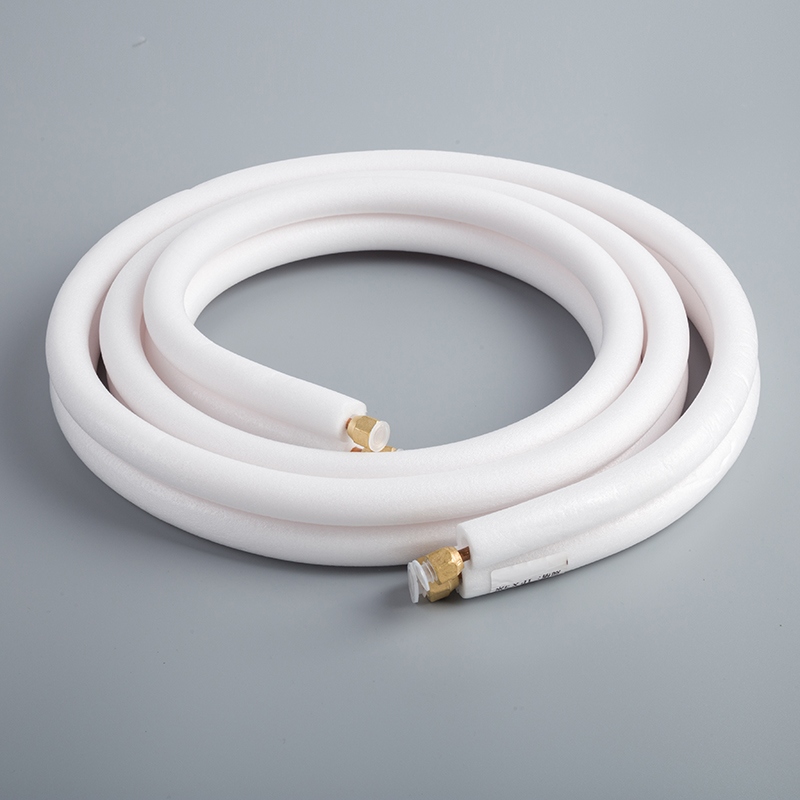Accurate Methods to Measure Copper Pipes

Guide to Measuring and Installing Copper Pipes
Accurate measurements play a crucial role in plumbing and construction. When it comes to copper pipes, precision is essential to ensure proper installation and functionality. Baoyuan, a leading manufacturer of pure copper connecting pipes for air conditioners, emphasizes the importance of accurate measurements for successful projects. Copper pipes are widely used in residential plumbing, commercial plumbing, and HVAC systems. Various tools and methods exist to measure copper pipes accurately, including measuring tapes, calipers, and pipe micrometers. Understanding these tools and techniques ensures reliable installations and successful outcomes. For more information on Baoyuan's products, visit https://copperpipe.net/products/.
Understanding Copper Pipes
Types of Copper Pipes
Type K
Type K copper pipe has the thickest wall among all common types. This type is used for water distribution, fire protection, oil, HVAC, and various other applications in the construction industry. The pipe is available in both rigid and flexible forms. It can be used with flared and compression fittings. The thickness of Type K makes it suitable for main water lines and underground installations. The pipe's durability allows it to withstand the pressure from backfilled earth in trenches. However, Type K is not approved for natural gas applications due to the potential damage to pipe joints.
Type L
Type L copper pipe is widely used for interior plumbing, fire protection, and some HVAC applications. This type is available in both rigid and flexible forms. It can be used with sweat, compression, and flare fittings. Type L is considered the most common type of copper piping because it suits many applications more than Type K. Flexible Type L copper can repair or replace old water lines, although rigid tubing offers more durability. Type L can also be used outside the home where it will be directly exposed. The wall thickness of Type L is thinner than Type K but thicker than Type M.
Type M
Type M copper pipe has a thinner wall compared to both Type K and Type L. This type is sold in both rigid and flexible forms. Type M is commonly used for domestic water service and vacuum systems. It can be used with sweat, compression, and flare fittings. Type M is favored for residential work due to its relatively low price; a thinner wall means less copper and thus a lower price. However, Type M is not allowed by plumbing codes in all areas and applications. Always check with the local building authority for restrictions on its use.
Common Applications
Residential Plumbing
Copper pipes are extensively used in residential plumbing. The pipes provide reliable water supply lines due to their excellent corrosion resistance and durability. Homeowners often choose Type L and Type M copper pipes for their plumbing needs. The flexibility of these pipes allows for easy installation and repairs. The pipes ensure a long-lasting and efficient water distribution system within homes.
Commercial Plumbing
In commercial plumbing, copper pipes play a vital role in ensuring robust and dependable water supply systems. Type K and Type L copper pipes are preferred for commercial applications due to their durability and ability to handle higher pressures. These pipes are used in office buildings, hospitals, and other commercial establishments. The pipes' corrosion resistance ensures a long service life, reducing maintenance costs and downtime.
HVAC Systems
Copper pipes are integral to HVAC systems. The pipes are used for refrigerant lines and water supply lines within heating, cooling, and air-conditioning systems. Type K and Type L copper pipes are commonly used in HVAC applications due to their ability to withstand high pressures and temperatures. The pipes' flexibility and ease of installation make them ideal for complex HVAC systems. The use of copper pipes ensures efficient and reliable operation of HVAC systems, contributing to energy savings and improved indoor comfort.
Standards and Specifications
Industry Standards
ASTM Standards
The American Society for Testing and Materials (ASTM) sets the standards for copper pipes. These standards ensure consistency and quality across various applications. ASTM B88 is the primary standard for seamless copper water tubes. This standard covers three types of copper pipes: Type K, Type L, and Type M. Each type has specific requirements for dimensions, mechanical properties, and chemical composition. Compliance with ASTM standards guarantees that copper pipes meet the necessary safety and performance criteria.
ANSI Standards
The American National Standards Institute (ANSI) also plays a crucial role in setting standards for copper pipes. ANSI standards focus on ensuring interoperability and compatibility among different products and systems. ANSI B16.22, for example, specifies the requirements for wrought copper and copper alloy solder-joint pressure fittings. These standards help maintain uniformity in manufacturing processes and product quality. Adhering to ANSI standards ensures that copper pipes and fittings perform reliably in various applications.
Pipe Dimensions
Outer Diameter (OD)
The outer diameter (OD) of copper pipes is a critical measurement. The OD determines the pipe's compatibility with fittings and other components. For rigid copper pipes, the actual OD is always 1/8 inch larger than the nominal size. For instance, a '1/2-inch' copper pipe has an OD of 5/8 inch. This measurement is consistent across all three common types: Type K, Type L, and Type M. Accurate OD measurements ensure proper fitting and installation of copper pipes.
Inner Diameter (ID)
The inner diameter (ID) of copper pipes varies based on the wall thickness. The ID is crucial for determining the flow capacity of the pipe. Thicker walls result in a smaller ID, which affects the volume of fluid the pipe can carry. For example, Type K pipes have the thickest walls and therefore the smallest ID among the three types. Understanding the ID is essential for selecting the appropriate pipe for specific applications, especially those involving fluid dynamics.
Wall Thickness
The wall thickness of copper pipes influences their strength and durability. Type K pipes have the thickest walls, making them suitable for high-pressure applications. Type L pipes have medium-thick walls, offering a balance between strength and flexibility. Type M pipes have the thinnest walls, making them ideal for low-pressure residential applications. Wall thickness directly impacts the pipe's ability to withstand internal and external pressures. Accurate measurement of wall thickness ensures the selection of the right type of copper pipe for any given project.
Tools for Measuring Copper Pipes

Measuring Tape
How to Use
A measuring tape is a versatile tool for measuring copper pipes. Wrap the tape around the pipe's circumference and mark the point where the tape meets itself. Measure the length of the tape from the starting point to the mark. Divide this measurement by pi (approximately 3.1415) to find the pipe's diameter. Ensure the tape is snug against the pipe for an accurate measurement.
Pros and Cons
Pros:
Easy to use
Widely available
Suitable for quick measurements
Cons:
Less precise than other tools
Potential for human error
Not ideal for small pipes
Calipers
How to Use
Calipers provide a more precise measurement for copper pipes. Open the calipers and place the tips on either side of the pipe. Close the calipers until the tips touch the pipe's outer edges. Read the measurement on the caliper scale. For inner diameter measurements, insert the caliper tips inside the pipe and expand them until they touch the inner walls.
Pros and Cons
Pros:
High precision
Suitable for both outer and inner diameter measurements
Reduces human error
Cons:
Requires calibration
More expensive than measuring tapes
May require practice to use effectively
Pipe Micrometers
How to Use
Pipe micrometers offer the highest precision for measuring copper pipes. Place the pipe between the micrometer's spindle and anvil. Rotate the thimble until the spindle touches the pipe. Read the measurement on the micrometer scale. For wall thickness measurements, use a micrometer designed for that purpose and follow the same procedure.
Pros and Cons
Pros:
Highest precision
Ideal for small pipes and detailed measurements
Reduces human error significantly
Cons:
Most expensive option
Requires calibration and maintenance
May be overkill for simple tasks
Step-by-Step Guide to Measuring Copper Pipes

Preparation
Gather Tools
Gathering the necessary tools ensures accurate measurements. Essential tools include a measuring tape, calipers, and pipe micrometers. Each tool serves a specific purpose in the measurement process. Having all tools ready before starting saves time and prevents interruptions.
Safety Precautions
Safety precautions protect against potential hazards. Wearing gloves shields hands from sharp edges. Using safety goggles prevents eye injuries from metal shavings. Ensuring a clean workspace reduces the risk of accidents. Following these precautions creates a safe environment for measuring copper pipes.
Measuring the Outer Diameter
Using a Measuring Tape
Using a measuring tape provides a quick way to measure the outer diameter. Wrap the tape around the pipe's circumference. Mark the point where the tape meets itself. Measure the length from the starting point to the mark. Divide this measurement by pi (approximately 3.1415) to find the diameter. Ensure the tape fits snugly against the pipe for accuracy.
Using Calipers
Calipers offer a more precise method for measuring the outer diameter. Open the calipers and place the tips on either side of the pipe. Close the calipers until the tips touch the pipe's outer edges. Read the measurement on the caliper scale. Calipers reduce human error and provide high precision.
Measuring the Inner Diameter
Using Calipers
Calipers also measure the inner diameter accurately. Insert the caliper tips inside the pipe. Expand the calipers until the tips touch the inner walls. Read the measurement on the caliper scale. This method ensures an accurate reading of the inner diameter.
Using Pipe Micrometers
Pipe micrometers provide the highest precision for measuring the inner diameter. Place the pipe between the micrometer's spindle and anvil. Rotate the thimble until the spindle touches the pipe. Read the measurement on the micrometer scale. This method offers detailed and accurate measurements, especially for small pipes.
Measuring Wall Thickness
Using Calipers
Calipers provide a precise method for measuring the wall thickness of copper pipes. Open the calipers and place the tips on either side of the pipe wall. Close the calipers until the tips touch the inner and outer surfaces of the pipe. Read the measurement on the caliper scale. This method ensures an accurate reading of the wall thickness.
Steps to Follow:
Open the calipers to a width slightly larger than the pipe wall.
Position the caliper tips on the inner and outer surfaces of the pipe wall.
Close the calipers gently until the tips make contact with the pipe surfaces.
Read the measurement displayed on the caliper scale.
Advantages:
High precision
Easy to use for various pipe sizes
Reduces human error
Disadvantages:
Requires calibration
More expensive than basic measuring tools
May need practice for effective use
Using Pipe Micrometers
Pipe micrometers offer the highest precision for measuring wall thickness. Place the pipe between the micrometer's spindle and anvil. Rotate the thimble until the spindle touches the pipe wall. Read the measurement on the micrometer scale. This method provides detailed and accurate measurements, especially for small pipes.
Steps to Follow:
Position the pipe between the micrometer's spindle and anvil.
Rotate the thimble until the spindle contacts the pipe wall.
Ensure the spindle makes firm but gentle contact with the pipe.
Read the measurement on the micrometer scale.
Advantages:
Highest precision available
Ideal for small pipes and detailed measurements
Significantly reduces human error
Disadvantages:
Most expensive option
Requires regular calibration and maintenance
May be overkill for simple tasks
Accurate wall thickness measurements ensure the selection of the appropriate type of copper pipe for any given project. Whether using calipers or pipe micrometers, precision in measurement guarantees reliable installations and successful outcomes.
Accurate measurements of copper pipes are essential for successful plumbing and construction projects. Various tools, such as measuring tapes, calipers, and pipe micrometers, provide precise measurements. Practicing these methods ensures precision and reliability in installations. Accurate measurements contribute significantly to the success of any project, reducing errors and ensuring long-lasting performance. Baoyuan's commitment to quality emphasizes the importance of these practices. For more information on Baoyuan's products, visit Baoyuan Products.
See Also
Simple Techniques for Measuring Copper Tubing Like an Expert
Quick Tutorial: Measuring Copper Pipe Like a Pro
Simple Methods: Measuring Copper Pipe for DIY Achievement


